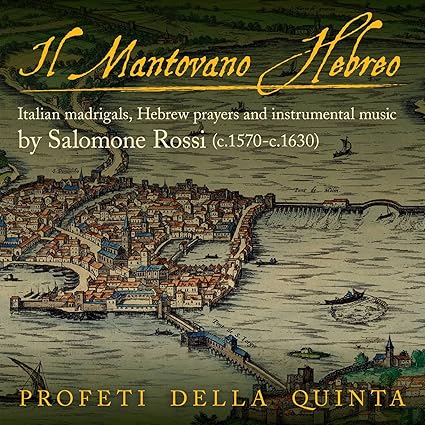Program: #14-26 Air Date: Jun 23, 2014
To listen to this show, you must first LOG IN. If you have already logged in, but you are still seeing this message, please SUBSCRIBE or UPGRADE your subscriber level today.
Recent releases of Monteverdi, Luigi Rossi, and the amazing “Mantovano Hebreo” Salamone Rossi.
I. Memento mori (Les Cris de Paris/Geoffrey Jourdain). Aparte CD AP059.

Created by Geoffroy Jourdain in 1999, Les Cris de Paris perform vocal and instrumental works from many eras, from the early sixteenth century to the present.
The booklet essay raises doubts as to the attribution of these works to Rossi and supposes that they were probably written for a period of penance in the liturgical year, perhaps during Lent.
II. Claudio Monteverdi: Madrigals (Arcangelo/Jonathan Cohen). Hyperion CD CDA68019.

All of Cohen’s singers come from the world of opera, and it shows in performances that place the drama of 'le parole' to the fore. The astonishing harmonic flexibility and melodic narrative of Monteverdi’s writing translates here into urgent drama. You can’t turn away from the musical convulsions of Clorinda’s death (Combattimento di Tancredi e Clorinda, Book 8), nor doubt the simple agony of the lover in Book 6’s Sestina Lagrime d'amante al sepolcro dell'amata. If occasionally voices over-exert, strive a little too earnestly to make their case (tenors and sopranos both push hard through the chorus ‘Ei l’armi cinse’ from Volgendo il ciel) then it seems a fair trade for so vivid an aural staging.
But among so much vocal athleticism, it’s still the instrumentalists of the ensemble that dominate, setting the disc apart from the excellent I Fagiolini recordings that come closest vocally to this kind of abandon. Sitting midway between the nervous energy of Alessandrini’s Concerto Italiano and the more measured intensity of Jordi Savall for the Book 8 works, Arcangelo’s musicians deploy rough-edged expressive risk-taking within a framework of complete stylistic control. The result is so exciting that Merula’s throwaway Ciaccona for violins and continuo—all quasi-improvisatory brilliance and fire—risks being the best thing here.
III. Il Mantovano hebreo: Italian Madrigals, Hebrew Prayers, and Instrumental music by Salomone Rossi (Profeti della Quinta). Linn CD CKD 429.

The program encompasses Rossi's many-faceted talents both as a court composer in the service of the Gonzaga family and as a unique innovator of devotional music for the synagogue. The award-winning a-cappella ensemble, comprising five core male singers, is joined for this recording by Katya Polin and Eva Saladin (violin) and Ori Harmelin and Ryosuke Sakamoto (theorbo). The native Hebrew speaking singers specialize in the music of the Italian Baroque and have an immediate connection to Rossi as a Jewish Italian composer.
In naming Profeti della Quinta winners of the 2011 York Early Music Young Artists Competition, producer and judge Philip Hobbs commented: ‘Profeti della Quinta's stunning authentic performance practice and quality of execution was truly magnificent.' The ensemble has recorded an accompanying documentary about Salomone Rossi, filmed in Mantua. For more information about this ensemble:
- 1. Psalm 128: Shir hamma'alót, Ashréi kol yeré Adonái
- 2. Sinfonia Prima a 5 e a 3 si placet
- 3. Sfogava con le stele
- 4. Sinfonia Prima
- 5. Tu parti, ahi lasso
- 6. Cor mio, deh non languire
- 7. Sinfonia Undecima
- 8. Udite, lacrimosi spirti d’averno
- 9. Sinfonia seconda, detta la Emiglia
- 10. Gagliarda a 5 e a 3 si placet, detta Narciso
- 11. Correnta terza
- 12. Brando second
- 13. Tirsi mio, caro Tirsi
- 14. Sinfonia quinta
- 15. Rimanti in pace
- 16. Sinfonia decima
- 17. Psalm 100: Mizmór letodá
- 18. Gagliarda disperata
- 19. Correnta sesta
- 20. Psalm 146: Haleluyáh
- 21. Vedrò ’l mio sol
- 22. Sinfonia Duodecima
- 23. In dolci lacci
- 24. Sonata ottava aria, E tanto tempo hormai
- 25. Ohimè, se tanto amate
- 26. Messaggier di speranza
- 27. Corrente settima
- 28. Gagliarda a 5 e a 3 si placet, detta la Zambalina
- 29. Pargoletta, che non sai
- 30. Psalm 126: Shir hama'alót, beshúv ‘adonái adonái
Composer Info
Salomone Rossi, Claudio Monteverdi (1567-1643), TARQUINIO MERULA (1594/5–1665), Luigi Rossi (ca 1597-1653),
CD Info
Aparte CD AP059, Linn CD CKD 429, Hyperion CD CDA68019,